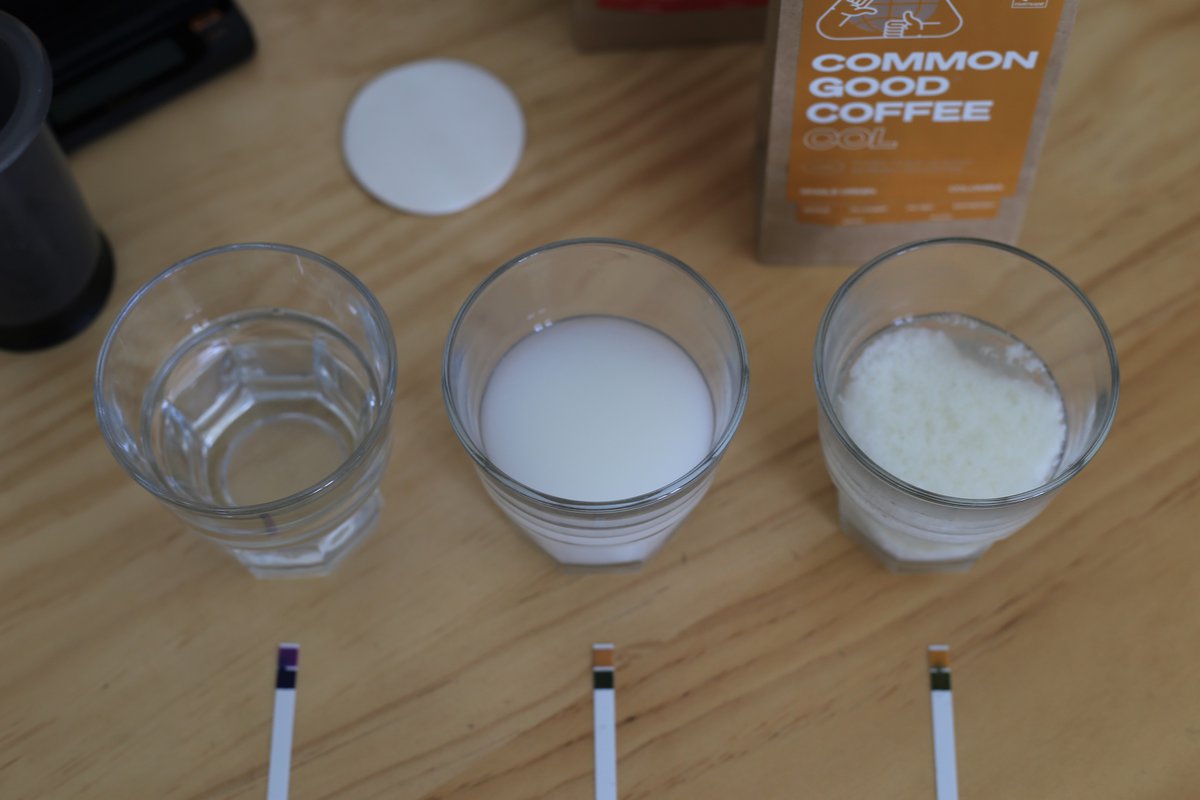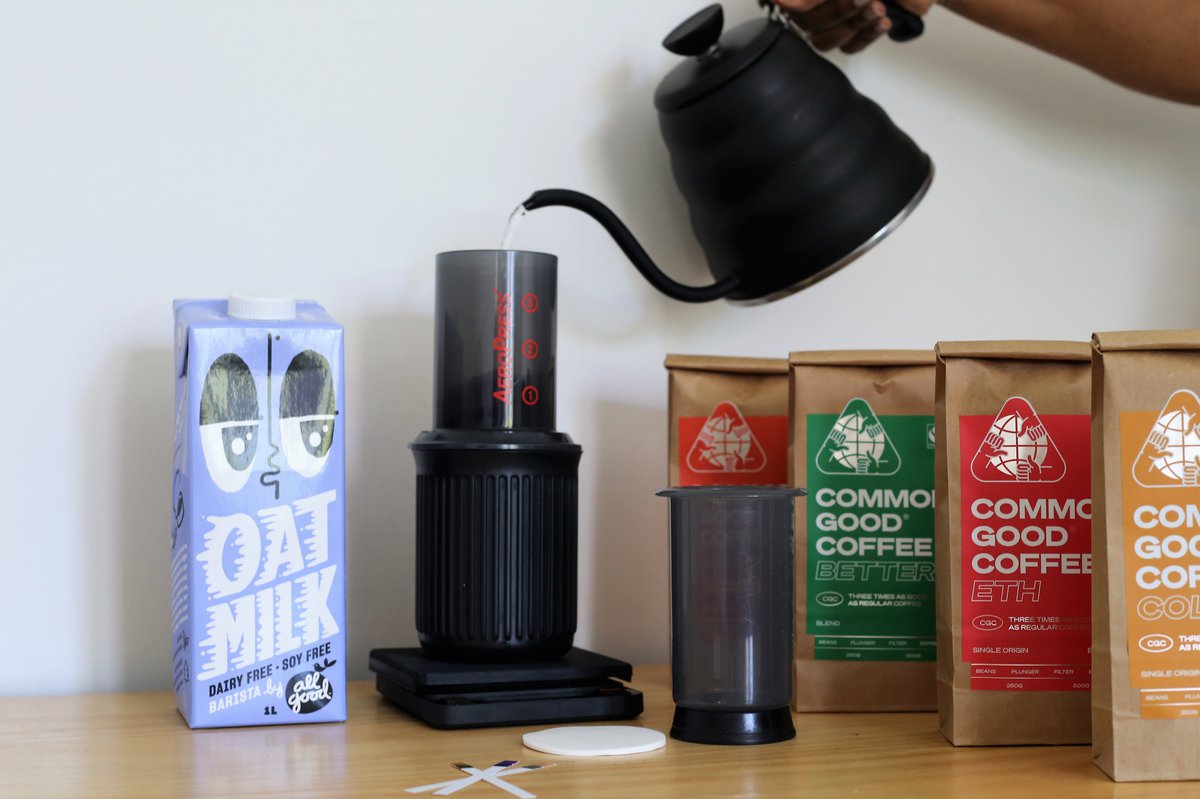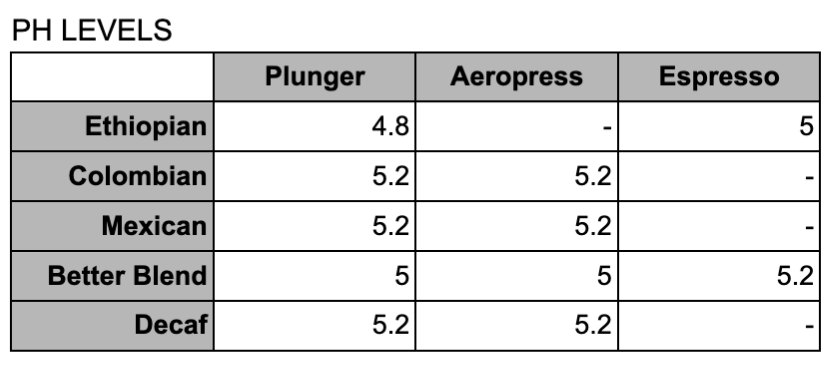By Ana Fletcher
I’ve recently gone dairy free. The main reasons behind this are health related for me. Until now, I have only really drunk coffee with milk. So the shift has been significant for me - plant based milk has previously been such an unknown.
My main concern was that I’d heard that certain coffees cause some plant milks to curdle. What if that happened with my favourite Common Good Coffee!? I set out to find out what my options were and whether the rumours were true when it came to my daily coffee. I’m not an expert or a scientist - but I learned some things along the way, and thought I’d share them with you.

Method: I had already done some pre-reading about grind and extraction time. I made each blend and origin of Common Good Coffee through at least two of three different methods (plunger, aeropress and espresso) using the standard grind settings on our EK43. I then used PH strips to test the acidity of each coffee. Then I tested different plant milks in an acidic solution at different PH levels and at different temperatures to see what happened.
Lesson #1: Use a recipe!
Using a recipe when making coffee makes a huge difference. In the interests of fairness, I had to consistently make each coffee the same way. I relied on different recipes from some coffee experts (Drumming Barista for plunger, James Hoffman for Aeropress and our very own roaster, Vernon Omeri for espresso). And here’s the thing - as a pretty hard core dairy lover and milk-only coffee drinker all four single origin coffees and the blend tasted so good black that I’ve actually started drinking them that way a lot of the time!
I was surprised by how easy the recipes were to follow (even first thing in the morning while heavily sleep deprived and a backing track of screaming kids). Totally felt like I nailed how to make coffee while doing this.
One of the interesting things about the recipes was the extraction time (fancy language for how long it takes to get the soluble compounds out of the coffee beans using water). The plunger and aeropress recipes were way longer than I’d normally wait. But the wait was worth it - it made such a difference to the overall flavour. An added bonus was it also meant that the coffee temperature by the end was lower (between 55-60C) which meant that plant milk was less likely to curdle.
We also used filtered water for our experiments for consistency. Even though it had almost identical PH level to tap water, we thought that it was better to take extra chemicals out of the equation just in case. I’m now using tap water every day and the difference is negligible.

Lesson #2: Not all plant milks are equal
My health condition combined with the challenges of a young family means that making my own plant milk is a step too far for me at the moment. I tried a few different types of plant milk (soy, almond, coconut and oat). I’m fortunate that I don’t have any allergies that rule out any of the plant milks on offer. What I did find was that the cheaper plant milks were really watery. I’m so used to the creaminess of real milk that I didn’t taste any benefit when adding them into my coffee, though I’d happily use them in cereal, smoothies, baking and so on. And then there were those that had their own strong flavour which I struggled to get used to in my coffee (I’m looking at you coconut!).
I also found that you get what you pay for in terms of quality. The ones that tasted better and produced the best textured milk tended to cost a bit more. They also generally tolerated a higher level of acidity - so they work with a broader range of coffees, both hot and cold. For me, that’s a win because I don’t have to worry about tricky methods to get a plant milk to work for me e.g. heating the plant milk first, waiting for the coffee to cool and then reheating it together.
Lesson #3: Common Good Coffee doesn’t curdle my mylk!
Last but definitely not least, given that this was the whole purpose of the experiment - apart from the cheapest supermarket soy milk in the Ethiopian, Common Good Coffee did not cause any of the plant milks that I used to curdle when I followed the recipes!
This has been a fun introduction for me to the world of coffee and plant based milk - and discovering that Common Good Coffee works great with plant milk was such a bonus. We’d love to hear from your experiences using plant milk and Common Good Coffee :-)

Experiments
In case you’re actually interested in the data I collected and the process we used. But please remember that I am not a scientist! This doesn’t mean that you will have the same experience - but hopefully it’s pretty close.
1. Recipes:
Drumming Barista’s Plunger Recipe for Common Good Coffee Mexican
James Hoffman’s Aeropress Recipe
Vernon Omeri’s Espresso for Common Good Coffee Better Blend: 21 grams in the basket, running a 25 second shot.
2. Coffee acidity
I’d done some earlier research on grind size and extraction time. The research suggested that the larger the grind size and shorter the extraction time would increase the acidity in the cup. I tested this hypothesis on the Blend (which is particularly intended for espresso) and also on the Ethiopian (which is our lightest roast and best drunk as a filter or plunger). Once I had these as a baseline, I didn’t run all the other singles through all three methods.

3. Plant milk curdle point
We made a solution with vinegar that we tested at both room temperature and 60C. We did this after the coffee PH experiments, so I knew the lowest PH level that we needed to test was 4.8 (though with some we went further). Additionally, we tested the temperature of each coffee at the end of its extraction time and all were below 60C so we used this temperature as a base point.
Cheapest Soy from Supermarket
PH 5 - No separation hot or cold solution.
PH 4.8 - Separates a lot in hot (60C) mixture, separates a little in room temperature solution.
Happy Happy Soy Boy
PH 4.8 - No separation in hot or cold solution.
PH 4.6 - Slight separation in cold solution, slightly more separation in hot solution. A quick stir fixed both.
Cheapest Almond milk from Supermarket
PH 4.8 - No separation in hot or cold solution.
Alpro Barista Almond Milk
PH 4.8 - No separation in hot or cold solution.
All Good Oat Milk
PH 4.8 - No separation in hot or cold solution.
PH 4.6 - No separation in hot or cold solution.
Little Island Coconut Milk
PH 4.8 - Slight separation at room temperature, very little separation at hot (60C).
